Impact of the 2023–2024 ENSO Event of the North Pacific Coral Reefs of Costa Rica
Abstract
1. Introduction
2. Materials and Methods
2.1. Study Area
2.2. Temperature and Thermal Stress Data
2.3. Field Assessments
2.3.1. Benthic Cover
2.3.2. Fish Community
2.4. Statistical Analysis
3. Results
3.1. Temperature and Thermal Stress
3.2. Benthic Cover
3.3. Fish Community
4. Discussion
5. Conclusions
Author Contributions
Funding
Institutional Review Board Statement
Data Availability Statement
Acknowledgments
Conflicts of Interest
Abbreviations
| ANOSIM | Analysis of similarities |
| CCA | Crustose coralline algae |
| CRW | Coral reef watch |
| DHW | Degree heating weeks |
| ENSO | El Niño-Southern Oscillation |
| ETP | Eastern Tropical Pacific |
| NMDS | Non-metric multidimensional scaling |
| NOAA | National Oceanographic and Atmospheric Administration |
| SST | Sea surface temperature |
Appendix A
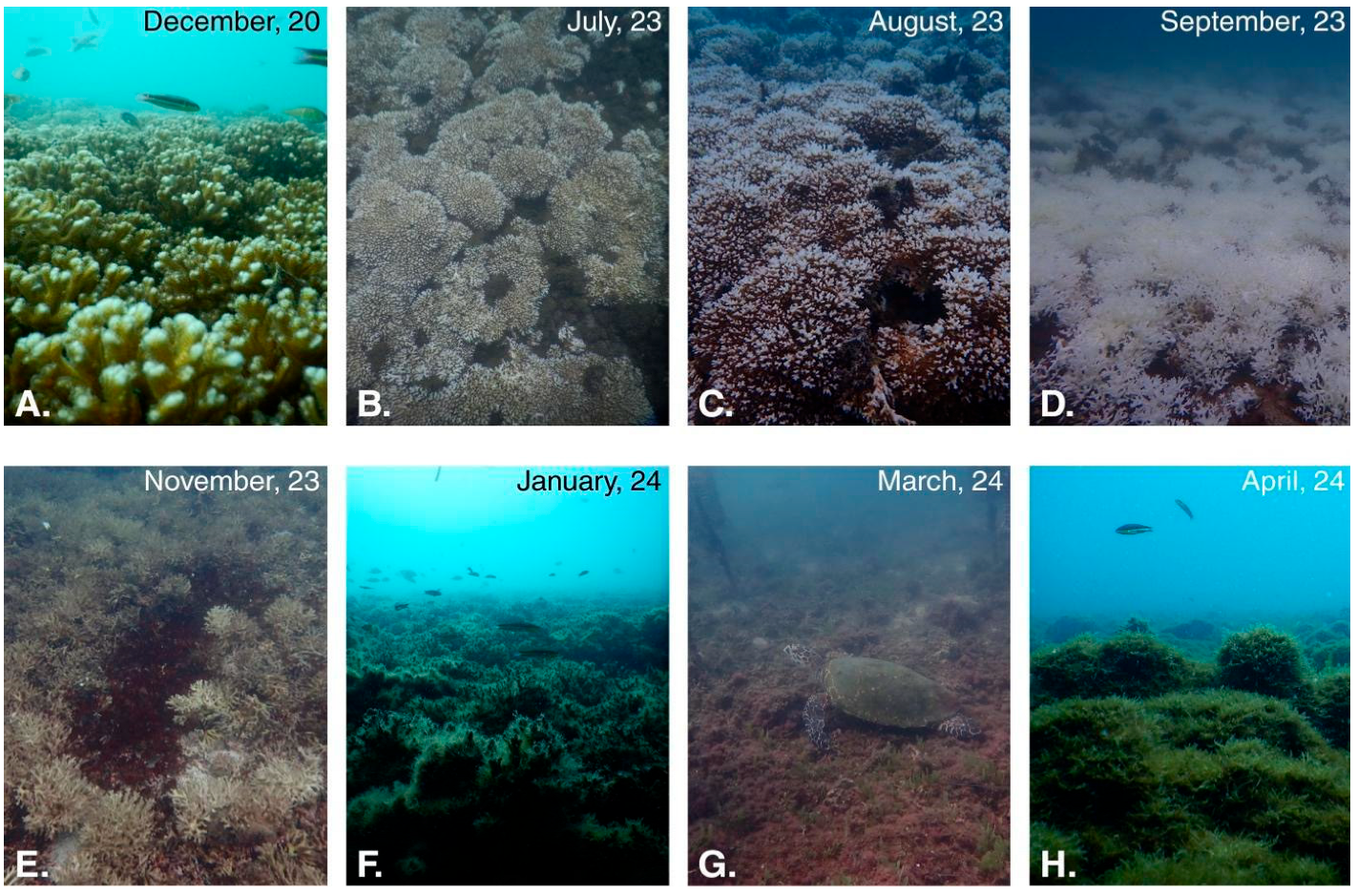
Appendix B

Appendix C

Appendix D
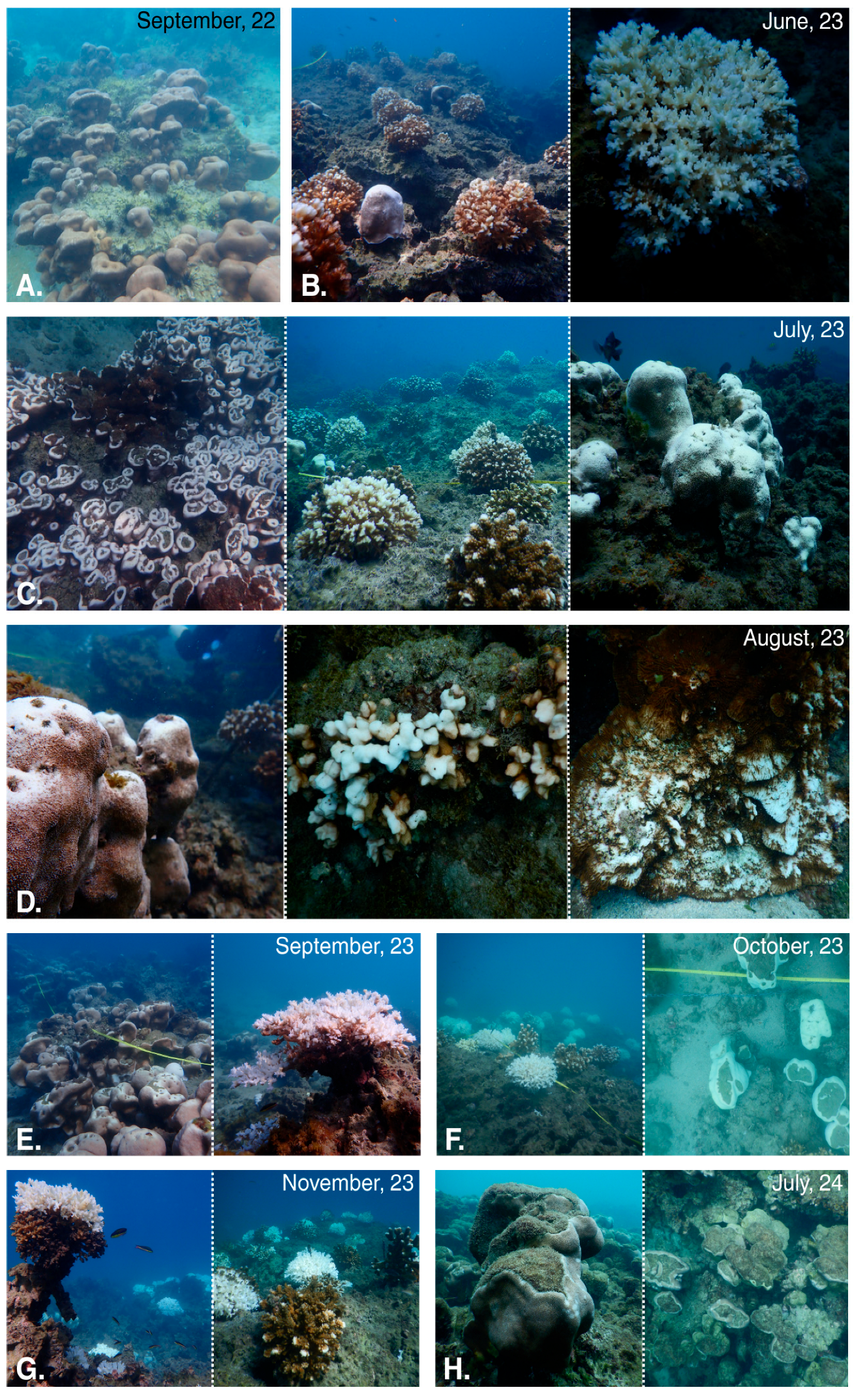
References
- Goreau, T.J.F.; Hayes, R.L. 2023 Record marine heat waves: Coral reef bleaching HotSpot maps reveal global sea surface temperature extremes, coral mortality, and ocean circulation changes. Oxf. Open Clim. Change 2024, 4, kgae005. [Google Scholar] [CrossRef]
- Hoegh-Guldberg, O. Climate change, coral bleaching and the future of the world’s coral reefs. Mar. Freshw. Res. 1999, 50, 839–866. [Google Scholar] [CrossRef]
- Hughes, T.P.; Anderson, K.D.; Connolly, S.R.; Heron, S.F.; Kerry, J.T.; Lough, J.M.; Baird, A.H.; Baum, J.K.; Berumen, M.L.; Bridge, T.C.; et al. Spatial and temporal patterns of mass bleaching of corals in the Anthropocene. Science 2018, 359, 80–83. [Google Scholar] [CrossRef]
- Claar, D.C.; Szostek, L.; McDevitt-Irwin, J.M.; Schanze, J.J.; Baum, J.K. Global patterns and impacts of El Niño events on coral reefs: A meta-analysis. PLoS ONE 2018, 13, e0190957. [Google Scholar] [CrossRef]
- Philander, S.G.H. El Niño southern oscillation phenomena. Nature 1983, 302, 295–301. [Google Scholar] [CrossRef]
- McPhaden, M.J.; Zebiak, S.E.; Glantz, M.H. ENSO as an integrating concept in earth science. Science 2006, 314, 1740–1745. [Google Scholar] [CrossRef]
- Barber, R.T.; Chavez, F.P. Biological consequences of El Niño. Science 1983, 222, 1203–1210. [Google Scholar] [CrossRef] [PubMed]
- Holmgren, M.; Scheffer, M.; Ezcurra, E.; Gutiérrez, J.R.; Mohren, G.M.J. El Niño effects on the dynamics of terrestrial ecosystems. Trends Ecol. Evol. 2001, 16, 89–94. [Google Scholar] [CrossRef] [PubMed]
- Glynn, P.W.; Mones, A.B.; Podestá, G.P.; Colbert, A.; Colgan, M.W. El Niño–Southern Oscillation: Effects on Eastern Pacific coral reefs and associated biota. In Coral Reefs of the Eastern Tropical Pacific; Glynn, P.W., Manzello, D., Enochs, I., Eds.; Coral Reefs of the World; Springer: Dordrecht, The Netherlands, 2017; pp. 251–290. [Google Scholar] [CrossRef]
- Baker, A.C.; Starger, C.; McClanahan, T.; Glynn, P.W. Corals’ adaptive response to climate change. Nature 2004, 430, 741. [Google Scholar] [CrossRef]
- Baker, A.C.; Glynn, P.W.; Riegl, B. Climate change and coral reef bleaching: An ecological assessment of long-term impacts, recovery trends and future outlook. Estuar. Coast. Shelf Sci. 2008, 80, 435–471. [Google Scholar] [CrossRef]
- Freeman, L.A.; Kleypas, J.A.; Miller, A.J. Coral reef habitat response to climate change scenarios. PLoS ONE 2013, 8, e82404. [Google Scholar] [CrossRef]
- Munday, P.L.; Jones, G.P.; Pratchett, M.S.; Williams, A.J. Climate change and the future for coral reef fishes. Fish Fish. 2008, 9, 261–285. [Google Scholar] [CrossRef]
- Harley, C.D.G.; Hughes, A.R.; Hultgren, K.M.; Miner, B.G.; Sorte, C.J.B.; Thornber, C.S.; Rodriguez, L.F.; Tomanek, L.; Williams, S.L. The impacts of climate change in coastal marine systems. Ecol. Lett. 2006, 9, 228–241. [Google Scholar] [CrossRef]
- Shanks, A.L.; Rasmuson, L.K.; Valley, J.R.; Jarvis, M.A.; Salant, C.; Sutherland, D.A.; Lamont, E.I.; Hainey, M.A.H.; Emlet, R.B. Marine heat waves, climate change, and failed spawning by coastal invertebrates. Limnol. Oceanogr. 2020, 65, 627–636. [Google Scholar] [CrossRef]
- Dalton, S.J.; Carroll, A.G.; Sampayo, E.; Roff, G.; Harrison, P.L.; Entwistle, K.; Huang, Z.; Salih, A.; Diamond, S.L. Successive marine heatwaves cause disproportionate coral bleaching during a fast phase transition from El Niño to La Niña. Sci. Total Environ. 2020, 715, 136951. [Google Scholar] [CrossRef] [PubMed]
- Hughes, T.P.; Kerry, J.T.; Álvarez-Noriega, M.; Álvarez-Romero, J.G.; Anderson, K.D.; Baird, A.H.; Babcock, R.C.; Beger, M.; Bellwood, D.R.; Berkelmans, R.; et al. Global warming and recurrent mass bleaching of corals. Nature 2017, 543, 373–377. [Google Scholar] [CrossRef]
- Reimer, J.D.; Peixoto, R.S.; Davies, S.W.; Traylor-Knowles, N.; Short, M.L.; Cabral-Tena, R.A.; Burt, J.A.; Pessoa, I.; Banaszak, A.T.; Winters, R.S.; et al. The fourth global coral bleaching event: Where do we go from here? Coral Reefs 2024, 43, 1121–1125. [Google Scholar] [CrossRef]
- Jiang, N.; Zhu, C.; Hu, Z.-Z.; McPhaden, M.J.; Lian, T.; Zhou, C.; Qian, W.; Chen, D. El Niño and sea surface temperature pattern effects lead to historically high global mean surface temperatures in 2023. Geophys. Res. Lett. 2025, 52, e2024GL113733. [Google Scholar] [CrossRef]
- Neely, K.L.; Nowicki, R.J.; Dobler, M.A.; Chaparro, A.A.; Miller, S.M.; Toth, K.A. Too hot to handle? The impact of the 2023 marine heatwave on Florida Keys coral. Front. Mar. Sci. 2024, 11, 1489273. [Google Scholar] [CrossRef]
- Byrne, M.; Waller, A.; Clements, M.; Kelly, A.S.; Kingsford, M.J.; Liu, B.; Reymond, C.E.; Vila-Concejo, A.; Webb, M.; Whitton, K.; et al. Catastrophic bleaching in protected reefs of the Southern Great Barrier Reef. Limnol. Oceanogr. Lett. 2025, 10, 340–348. [Google Scholar] [CrossRef]
- López-Pérez, A.; Granja-Fernández, R.; Ramírez-Chávez, E.; Valencia-Méndez, O.; Rodríguez-Zaragoza, F.A.; González-Mendoza, T.; Martínez-Castro, A. Widespread coral bleaching and mass mortality of reef-building corals in Southern Mexican Pacific reefs due to 2023 El Niño warming. Oceans 2024, 5, 196–209. [Google Scholar] [CrossRef]
- Guzman, H.M.; Cortés, J.; Richmond, R.H.; Glynn, P.W. Efectos del fenómeno de “El Niño-Oscilación Sureña” 1982–83 en los arrecifes coralinos de la Isla del Caño, Costa Rica. Rev. Biol. Trop. 1987, 35, 325–332. [Google Scholar]
- Jiménez, C.; Cortés, J. Effects of the 1991–1992 El Niño on scleractinian corals of the Costa Rican central Pacific coast. Rev. Biol. Trop. 2001, 49, 239–250. [Google Scholar]
- Jiménez, C.E.; Cortés, J. Coral cover change associated to El Niño, eastern Pacific, Costa Rica, 1992–2001. Mar. Ecol. 2003, 24, 179–192. [Google Scholar] [CrossRef]
- Guzman, H.M.; Cortés, J. Cocos Island (Pacific of Costa Rica) coral reefs after the 1982–83 El Niño disturbance. Rev. Biol. Trop. 1992, 40, 309–324. [Google Scholar]
- Guzman, H.M.; Cortés, J. Reef recovery 20 years after the 1982–83 El Niño massive mortality. Mar. Biol. 2007, 151, 401–411. [Google Scholar] [CrossRef]
- Jiménez, C.; Cortés, J.; León, A.; Ruiz, E. Coral bleaching and mortality associated with the 1997–98 El Niño in an upwelling environment in the eastern Pacific (Gulf of Papagayo, Costa Rica). Bull. Mar. Sci. 2001, 69, 151–169. [Google Scholar]
- Alvarado, J.J.; Sánchez-Noguera, C.; Arias-Godínez, G.; Araya, T.; Fernández-García, C.; Guzman, A.G. Impact of El Niño 2015–2016 on the coral reefs of the Pacific of Costa Rica: The potential role of marine protection. Rev. Biol. Trop. 2019, 68, S271–S282. [Google Scholar] [CrossRef]
- Cortés, J.; Jiménez, C.E. Corals and coral reefs of the Pacific of Costa Rica: History, research and status. In Latin American Coral Reefs; Cortés, J., Ed.; Elsevier: Berlin, Germany, 2003; pp. 361–385. [Google Scholar] [CrossRef]
- Romero-Torres, M.; Acosta, A.; Palacio-Castro, A.M.; Treml, E.A.; Zapata, F.A.; Paz-García, D.A.; Porter, J.W. Coral reef resilience to thermal stress in the Eastern Tropical Pacific. Glob. Change Biol. 2020, 26, 3880–3890. [Google Scholar] [CrossRef]
- Jiménez, C.; Bassey, G.; Segura, A.; Cortés, J. Characterization of the coral communities and reefs of two previously undescribed locations in the upwelling region of Gulf of Papagayo (Costa Rica). Rev. Cienc. Mar. Costeras 2010, 2, 95–108. [Google Scholar] [CrossRef]
- Alfaro, E.J.; Cortés, J.; Alvarado, J.J.; Jiménez, C.; León, A.; Sánchez-Noguera, C.; Nivia-Ruiz, J.; Ruiz, E. Clima y variabilidad climática de la temperatura subsuperficial del mar en Bahía Culebra, Guanacaste, Costa Rica. Rev. Biol. Trop. 2012, 60, 159–171. [Google Scholar] [CrossRef]
- Rixen, T.; Jiménez, C.; Cortés, J. Impact of upwelling events on the sea water chemistry in the Gulf of Papagayo (Culebra Bay), Costa Rica. Rev. Biol. Trop. 2012, 60, 187–195. [Google Scholar] [CrossRef]
- Stuhldreier, I.; Sánchez-Noguera, C.; Rixen, T.; Cortés, J.; Morales, A.; Wild, C. Effects of seasonal upwelling on inorganic and organic matter dynamics in the water column of Eastern Pacific coral reefs. PLoS ONE 2015, 10, e0142681. [Google Scholar] [CrossRef]
- Sánchez-Noguera, C.; Stuhldreier, I.; Cortés, J.; Jiménez, C.; Morales, A.; Wild, C.; Rixen, T. Natural ocean acidification at Papagayo upwelling system (North Pacific Costa Rica): Implications for reef development. Biogeosciences 2018, 15, 2349–2360. [Google Scholar] [CrossRef]
- Liu, G.; Heron, S.F.; Eakin, C.M.; De La Cour, J.L.; Geiger, E.F.; Tirak, K.V.; Skirving, W.J.; Strong, A.E. NOAA Coral Reef Watch (CRW) daily global 5-km (0.05 Degree) satellite coral bleaching heat stress monitoring product suite. NOAA National Centers for Environmental Information: Asheville, NC, USA, 2018. Available online: https://doi.org/10.25921/6jgr-pt28 (accessed on 2 April 2025).
- Glynn, P.W.; D’Croz, L. Experimental Evidence for high temperature stress as the cause of El Niño coincident coral mortality. Coral Reefs 1990, 8, 181–191. [Google Scholar] [CrossRef]
- Harriott, V.J.; Banks, S.A. Latitudinal variation in coral communities in Eastern Australia: A qualitative biophysical model of factors regulating coral reefs. Coral Reefs 2002, 21, 83–94. [Google Scholar] [CrossRef]
- Kleypas, J.A.; McManus, J.W.; Meñez, L.A.B. Environmental limits to coral reef development: Where do we draw the line? Am. Zool. 1999, 39, 146–159. [Google Scholar] [CrossRef]
- Glynn, P.W.; Wellington, G.M. Corals and Coral Reefs of the Galápagos Islands; University of California Press: Berkeley, CA, USA, 1983; p. 330. [Google Scholar] [CrossRef]
- Trygonis, V.; Sini, M. photoQuad: A dedicated seabed image processing software, and a comparative error analysis of four photoquadrat methods. J. Exp. Mar. Biol. Ecol. 2012, 424–425, 99–108. [Google Scholar] [CrossRef]
- Alvarado, J.J.; Beita, A.; Mena, S.; Fernández-García, C.; Guzmán, A.G. Ecosistemas coralinos del Área de Conservación Osa, Costa Rica: Análisis estructural y necesidades de conservación. Rev. Biol. Trop. 2015, 63, 219–259. [Google Scholar] [CrossRef]
- Alvarado, J.J.; Beita, A.; Mena, S.; Fernández-García, C.; Guzmán, A.G.; Cortés, J. Ecosistemas coralinos del Parque Nacional Isla del Coco, Costa Rica: Análisis estructural y temporal. Rev. Biol. Trop. 2016, 64, 153–175. [Google Scholar] [CrossRef]
- Froese, R.; Pauly, D. FishBase. World Wide Web Electronic Publication. 2016. Available online: http://www.fishbase.org/ (accessed on 16 October 2016).
- Cambronero-Solano, S.; Tisseaux-Navarro, A.; Vargas-Hernández, J.M.; Salazar-Ceciliano, J.P.; Benavides-Morera, R.; Quesada-Ávila, I.; Brenes-Rodríguez, C. Hydrographic variability in the Gulf of Papagayo, Costa Rica during 2017–2019. Rev. Biol. Trop. 2021, 69, S74–S93. [Google Scholar] [CrossRef]
- Hidalgo-Sánchez, R.; Alvarado, J.J.; Araya-Valverde, E.; Díaz-Ferguson, E. Genetic diversity and structure of Pocillopora spp. corals in the Gulf of Papagayo, Costa Rica. Discov. Ocean. 2025, 2, 16. [Google Scholar] [CrossRef]
- Alfaro-Monge, B.C. Diversidad genética de los endosimbiontes dinoflagelados (Dinophyceae: Symbiodiniaceae) de los corales hermatípicos en Bahía Culebra, Pacífico de Costa Rica. Licenciatura Thesis, Universidad de Costa Rica, San José, Costa Rica, 2025. [Google Scholar]
- Millán-Márquez, A.M.; Velasco-Montoya, D.A.; Terraneo, T.I. Symbiodiniaceae diversity in Pocillopora corals in different environments of the Colombian Eastern Pacific: Symbiont specificity in spite of coral-host flexibility. Coral Reefs 2024, 43, 1581–1597. [Google Scholar] [CrossRef]
- Thornhill, D.J.; LaJeunesse, T.C.; Kemp, D.W.; Fitt, W.K.; Schmidt, G.W. Multi-year, seasonal genotypic surveys of coral–algal symbioses reveal prevalent stability or post-bleaching reversion. Mar. Biol. 2006, 148, 711–722. [Google Scholar] [CrossRef]
- Goulet, T.L.; LaJeunesse, T.C.; Fabricius, K.E. Symbiont specificity and bleaching susceptibility among soft corals in the 1998 Great Barrier Reef mass coral bleaching event. Mar. Biol. 2008, 154, 795–804. [Google Scholar] [CrossRef]
- Kemp, D.W.; Hoadley, K.D.; Lewis, A.M.; Wham, D.C.; Smith, R.T.; Warner, M.E.; LaJeunesse, T.C. Thermotolerant coral–algal mutualisms maintain high rates of nutrient transfer while exposed to heat stress. Proc. R. Soc. B 2023, 290, 20231403. [Google Scholar] [CrossRef] [PubMed]
- Glynn, P.W.; Maté, J.L.; Baker, A.C.; Calderón, M.O. Coral bleaching and mortality in Panama and Ecuador during the 1997–1998 El Niño–Southern Oscillation event: Spatial/temporal patterns and comparisons with the 1982–1983 event. Bull. Mar. Sci. 2001, 69, 79–109. [Google Scholar]
- Fabregat-Malé, S.; Mena, S.; Alvarado, J.J. Nursery-reared coral outplanting success in an upwelling-influenced area in Costa Rica. Rev. Biol. Trop. 2023, 71, e54879. [Google Scholar] [CrossRef]
- Fabregat-Malé, S.; Mena-González, S.; Quesada-Perez, F.; Alvarado, J.J. Testing the feasibility of coral nurseries in an upwelling area in the North Pacific of Costa Rica. Front. Mar. Sci. 2024, 11, 1400026. [Google Scholar] [CrossRef]
- Hughes, A.D.; Grottoli, A.G. Heterotrophic compensation: A possible mechanism for resilience of coral reefs to global warming or a sign of prolonged stress? PLoS ONE 2013, 8, e81172. [Google Scholar] [CrossRef]
- Martinez, S.; Grover, R.; Ferrier-Pagès, C. Unveiling the importance of heterotrophy for coral symbiosis under heat stress. mBio 2024, 15, e01966-24. [Google Scholar] [CrossRef]
- Wang, Q.; Zheng, X.; Zhou, X.; Zhang, H.; Cai, L.; Leung, J.Y.S.; Huang, L. Symbiont genus determines the trophic strategy of corals: Implications for intraspecific competition for energy sources in coral reefs. Ecol. Indic. 2024, 158, 111477. [Google Scholar] [CrossRef]
- Palmer, C.; Jimenez, C.; Bassey, G.; Ruiz, E.; Villalobos-Cubero, T.; Chavarria-Diaz, M.M.; Harrison, X.A.; Puschendorf, R. Cold water and harmful algal blooms linked to coral reef collapse in the Eastern Tropical Pacific. PeerJ 2022, 10, e14081. [Google Scholar] [CrossRef]
- Randall, C.J.; Toth, L.T.; Leichter, J.J.; Maté, J.L.; Aronson, R.B. Upwelling buffers climate change impacts on coral reefs of the eastern tropical Pacific. Ecology 2020, 101, e02918. [Google Scholar] [CrossRef] [PubMed]
- Zhu, W.; Ren, Y.; Liu, X.; Huang, D.; Xia, J.; Zhu, M.; Yin, H.; Chen, R.; Li, X. The impact of coastal upwelling on coral reef ecosystems under anthropogenic influence: Coral reef community and its response to environmental factors. Front. Mar. Sci. 2022, 9, 888888. [Google Scholar] [CrossRef]
- Riegl, B.; Glynn, P.W.; Banks, S.; Keith, I.; Rivera, F.; Vera-Zambrano, M.; D’Angelo, C.; Wiedenmann, J. Heat attenuation and nutrient delivery by localized upwelling avoided coral bleaching mortality in northern Galapagos during 2015/2016 ENSO. Coral Reefs 2019, 38, 773–785. [Google Scholar] [CrossRef]
- Wilson, S.K.; Graham, N.A.; Pratchett, M.S.; Jones, G.P.; Polunin, N.V. Multiple disturbances and the global degradation of coral reefs: Are reef fishes at risk or resilient? Glob. Change Biol. 2006, 12, 2220–2234. [Google Scholar] [CrossRef]
- Graham, N.A.; Cinner, J.E.; Norström, A.V.; Nyström, M. Coral reefs as novel ecosystems: Embracing new futures. Curr. Opin. Environ. Sustain. 2014, 7, 9–14. [Google Scholar] [CrossRef]
- Garpe, K.C.; Yahya, S.A.S.; Lindahl, U.; Öhman, M.C. Long-term effects of the 1998 coral bleaching event on reef fish assemblages. Mar. Ecol. Prog. Ser. 2006, 315, 237–247. [Google Scholar] [CrossRef]
- Williamson, D.H.; Ceccarelli, D.M.; Evans, R.D.; Lamb, S.D.; Russ, G.R. Habitat dynamics, marine reserve status, and the decline and recovery of coral reef fish communities. Ecol. Evol. 2014, 4, 337–354. [Google Scholar] [CrossRef]
- Pratchett, M.S.; Hoey, A.S.; Wilson, S.K.; Messmer, V.; Graham, N.A.J. Changes in biodiversity and functioning of the reef fish assemblages following coral bleaching and coral loss. Diversity 2011, 3, 424–452. [Google Scholar] [CrossRef]
- Pratchett, M.S.; Munday, P.L.; Wilson, S.K.; Graham, N.A.; Cinner, J.E.; Bellwood, D.R.; Mcclanahan, T.R. Effects of climate-induced coral bleaching on coral-reef fishes—Ecological and economic consequences. In Oceanography and Marine Biology: An Annual Review; CRC Press: Boca Raton, FL, USA, 2008; Volume 46, pp. 257–302. [Google Scholar] [CrossRef]
- Mena, S.; Quesada-Perez, F.; Sánchez-Noguera, C.; Salas-Moya, C.; Alvarado, J.J.; López-Garro, A.; López, L.F. Estructura comunitaria de ecosistemas coralinos en sitios de importancia para la conservación de la biodiversidad marina del Pacífico Norte de Costa Rica. Rev. Biol. Trop. 2025, 73, e63715. [Google Scholar] [CrossRef]
- Edwards, C.B.; Friedlander, A.M.; Green, A.G.; Hardt, M.J.; Sala, E.; Sweatman, H.P.; Williams, I.D.; Zgliczynski, B.; Sandin, S.A.; Smith, J.E. Global assessment of the status of coral reef herbivorous fishes: Evidence for fishing effects. Proc. R. Soc. B 2014, 281, 20131835. [Google Scholar] [CrossRef]
- Tebbett, S.B.; Chase, T.J.; Bellwood, D.R. Farming damselfishes shape algal turf sediment dynamics on coral reefs. Mar. Environ. Res. 2020, 160, 104988. [Google Scholar] [CrossRef]
- Alvarado, J.J.; Grassian, B.; Cantera-Kintz, J.R.; Carballo, J.L.; Londoño-Cruz, E. Coral reef bioerosion in the eastern tropical Pacific. In Coral Reefs of the Eastern Tropical Pacific: Persistence and Loss in a Dynamic Environment; Glynn, P.W., Manzello, D.P., Enochs, I.C., Eds.; Springer: Dordrecht, The Netherlands, 2017; pp. 369–403. [Google Scholar] [CrossRef]
- Perry, C.T.; Salter, M.A.; Lange, I.D.; Kochan, D.P.; Harborne, A.R.; Graham, N.A. Geo-ecological functions provided by coral reef fishes vary among regions and impact reef carbonate cycling regimes. Ecosphere 2022, 13, e4288. [Google Scholar] [CrossRef]
- Quimbayo, J.P.; Mendes, T.C.; Kulbicki, M.; Floeter, S.R.; Zapata, F.A. Unusual reef fish biomass and functional richness at Malpelo, a remote island in the Tropical Eastern Pacific. Environ. Biol. Fishes 2017, 100, 149–162. [Google Scholar] [CrossRef]
- Gijón-Díaz, D.; Reyes-Bonilla, H.; Guerrero-Izquierdo, T.P.; Fernández-Rivera Melo, F.J. Potencial económico de la captura de peces de ornato bajo protección federal en México. Rev. Biol. Trop. 2017, 65, 195–210. [Google Scholar] [CrossRef]
- Reyes-Bonilla, H.; Morello, G.; Calderon-Aguilera, L.E.; Velasco-Lozano, M.; Ramírez-Ortiz, G.; Morales-MontesDeOca, E. Ecosystem services offered by fishes in shallow and mesophotic reefs of the southern Gulf of California. Biodivers. Conserv. 2025, 34, 1903–1928. [Google Scholar] [CrossRef]
- Costanza, R.; de Groot, R.; Braat, L.; Kubiszewski, I.; Fioramonti, L.; Sutton, P.; Farber, S.; Grasso, M. Twenty years of ecosystem services: How far have we come and how far do we still need to go? Ecosyst. Serv. 2017, 28, 1–16. [Google Scholar] [CrossRef]
- Holstein, D.M.; Fletcher, P.; Groves, S.H.; Smith, T.B. Ecosystem services of mesophotic coral ecosystems and a call for better accounting. In Mesophotic Coral Ecosystems; Loya, Y., Puglise, K.A., Bridge, T.C.L., Eds.; Springer: Cham, Switzerland, 2019; pp. 943–956. [Google Scholar] [CrossRef]
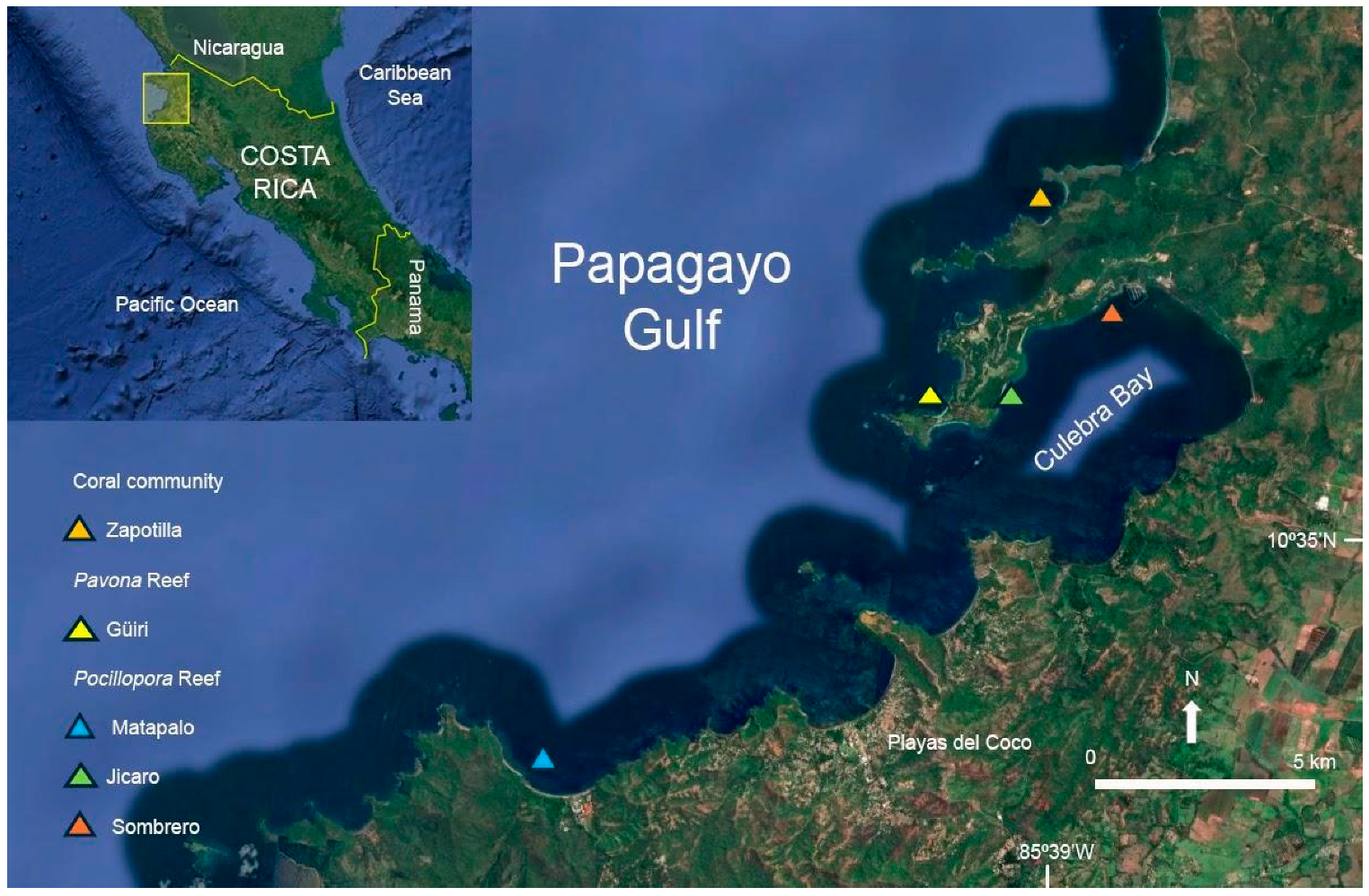
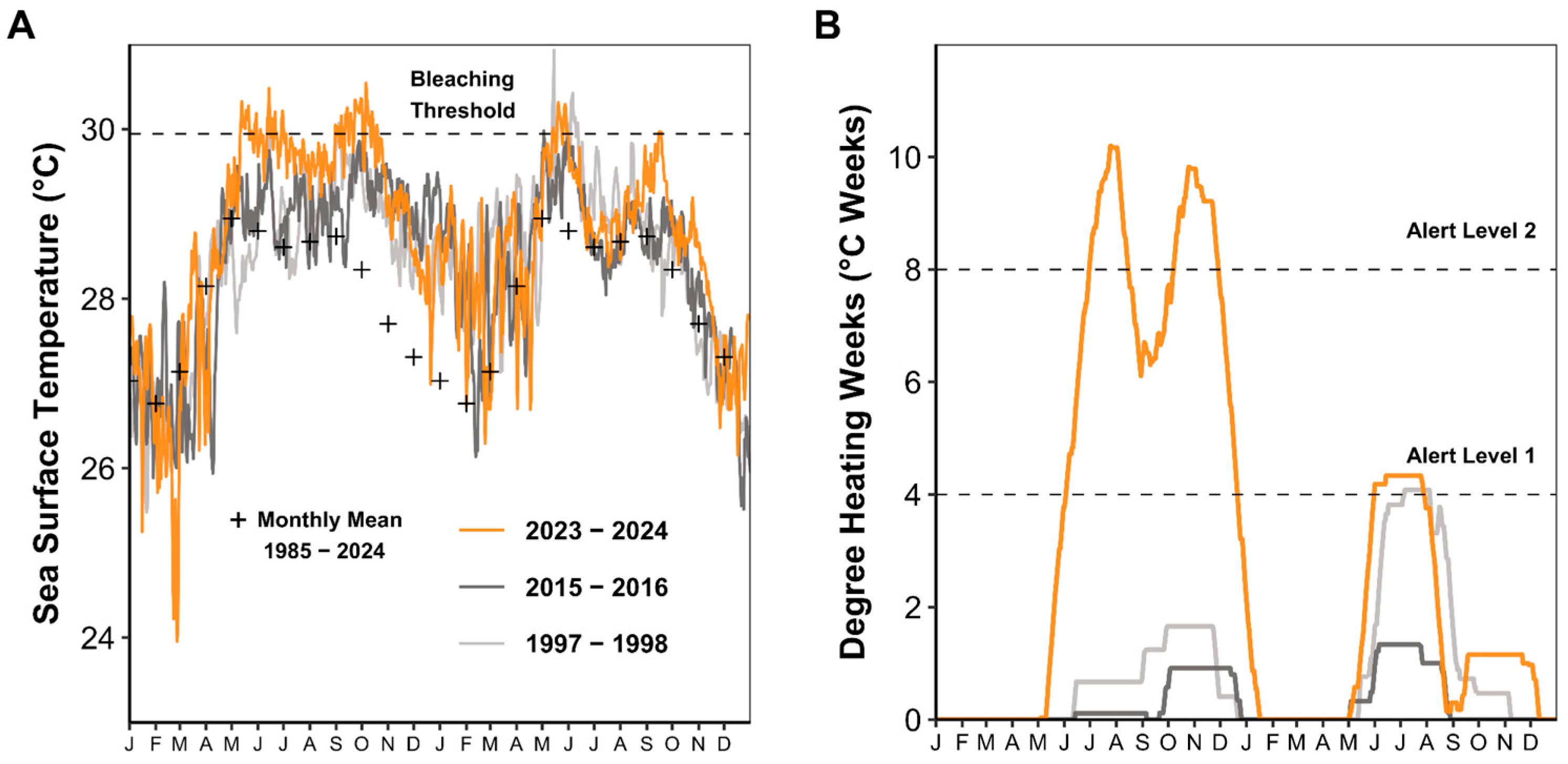
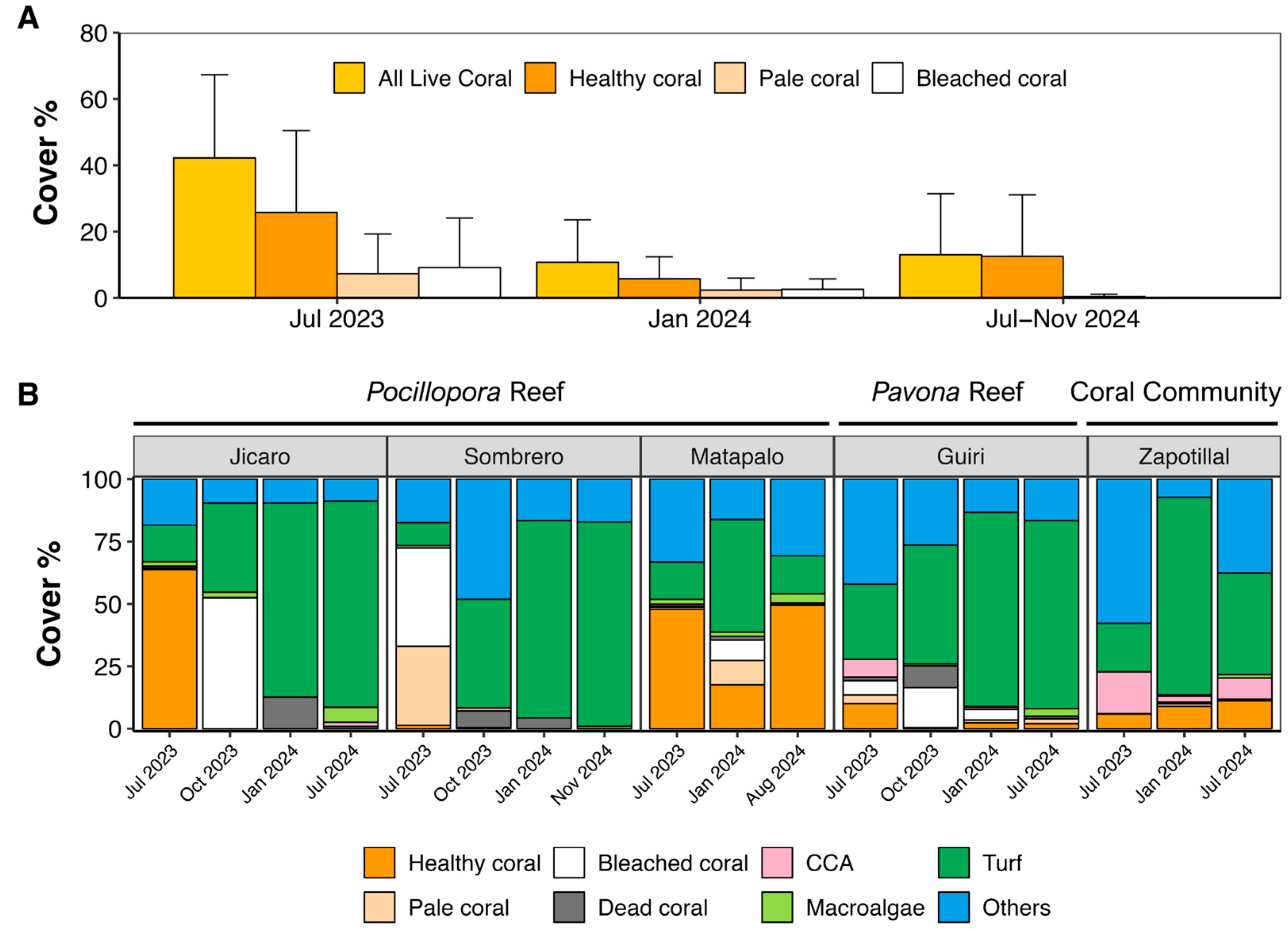
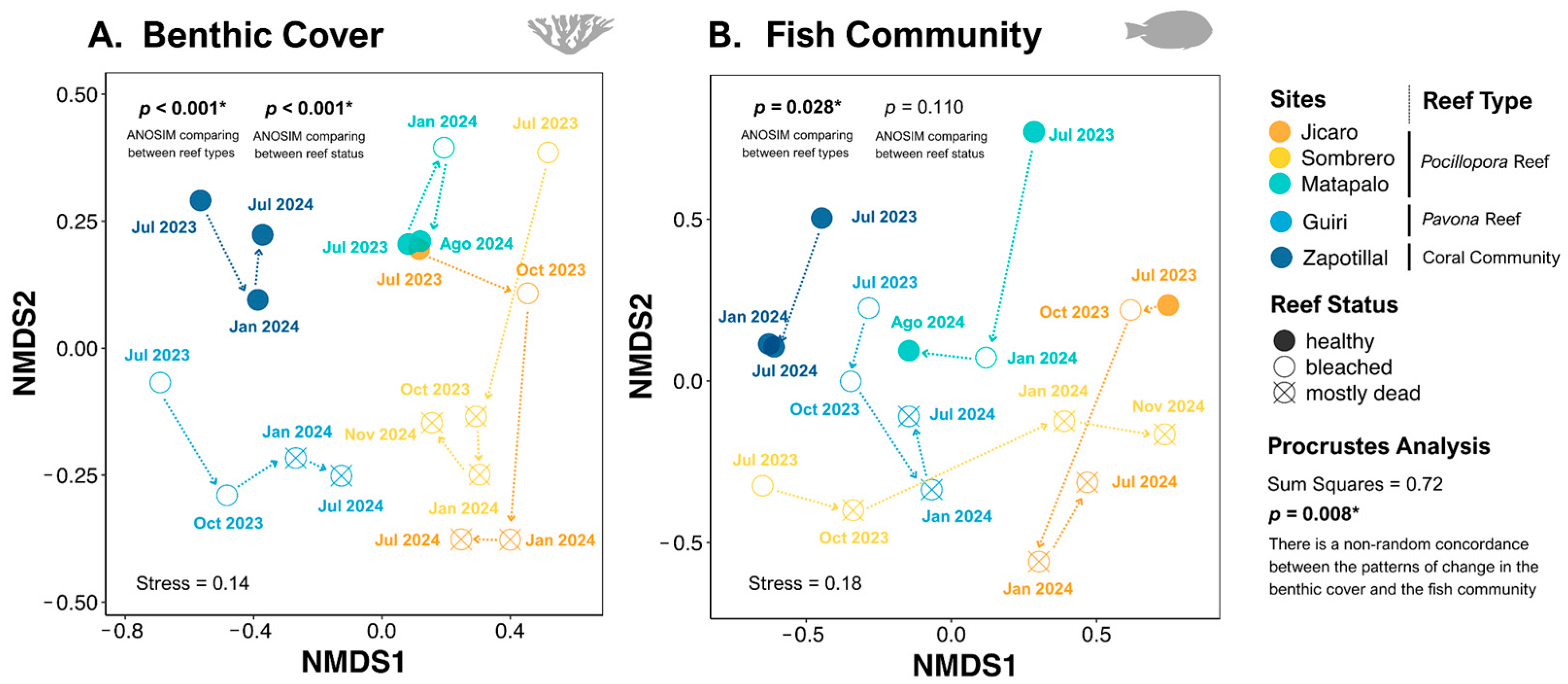
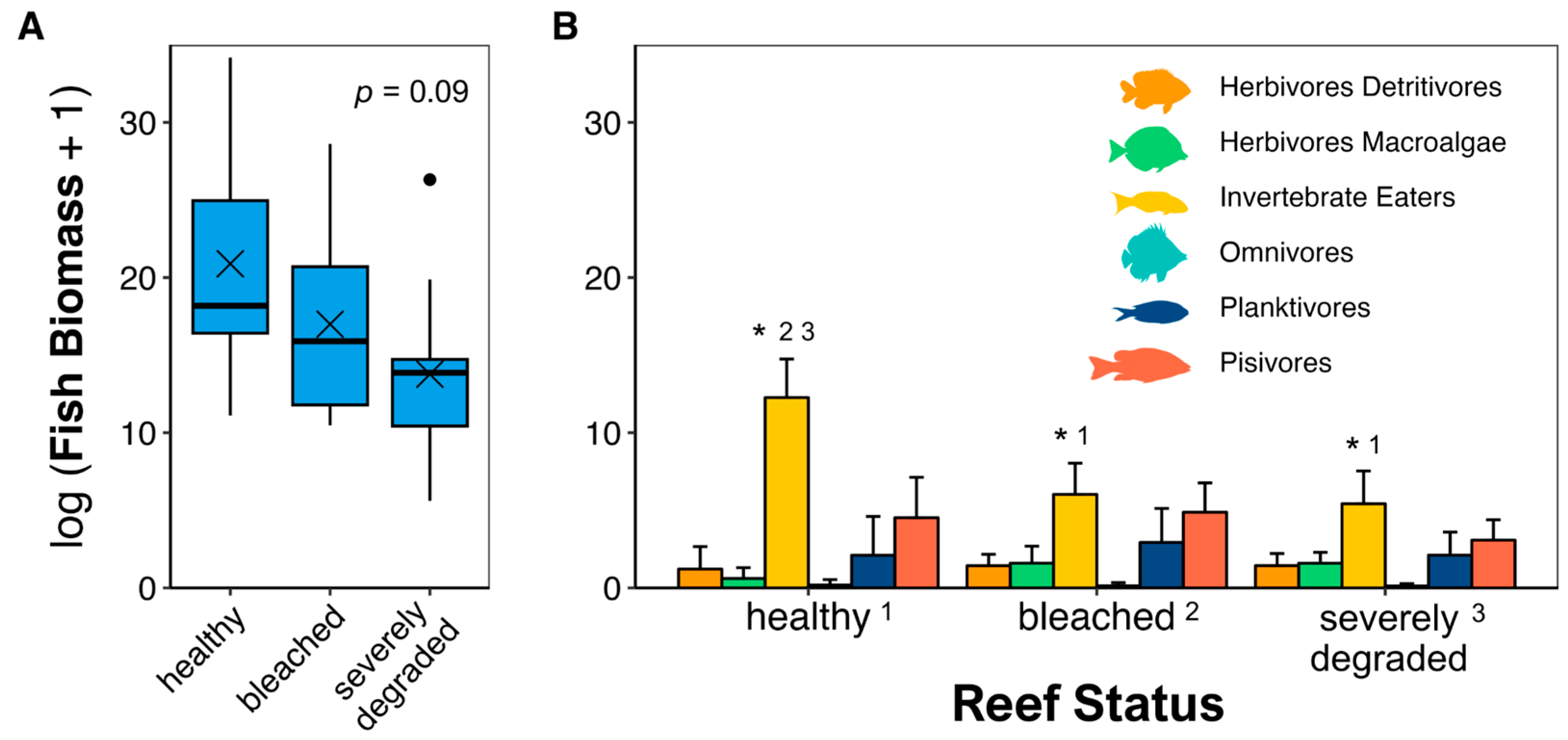
Disclaimer/Publisher’s Note: The statements, opinions and data contained in all publications are solely those of the individual author(s) and contributor(s) and not of MDPI and/or the editor(s). MDPI and/or the editor(s) disclaim responsibility for any injury to people or property resulting from any ideas, methods, instructions or products referred to in the content. |
© 2025 by the authors. Licensee MDPI, Basel, Switzerland. This article is an open access article distributed under the terms and conditions of the Creative Commons Attribution (CC BY) license (https://creativecommons.org/licenses/by/4.0/).
Share and Cite
Alvarado, J.J.; Quesada-Perez, F.; Solano, M.J.; Calvo-Fong, M.; Mena, S. Impact of the 2023–2024 ENSO Event of the North Pacific Coral Reefs of Costa Rica. Diversity 2025, 17, 791. https://doi.org/10.3390/d17110791
Alvarado JJ, Quesada-Perez F, Solano MJ, Calvo-Fong M, Mena S. Impact of the 2023–2024 ENSO Event of the North Pacific Coral Reefs of Costa Rica. Diversity. 2025; 17(11):791. https://doi.org/10.3390/d17110791
Chicago/Turabian StyleAlvarado, Juan José, Fabio Quesada-Perez, María J. Solano, Maricruz Calvo-Fong, and Sebastián Mena. 2025. "Impact of the 2023–2024 ENSO Event of the North Pacific Coral Reefs of Costa Rica" Diversity 17, no. 11: 791. https://doi.org/10.3390/d17110791
APA StyleAlvarado, J. J., Quesada-Perez, F., Solano, M. J., Calvo-Fong, M., & Mena, S. (2025). Impact of the 2023–2024 ENSO Event of the North Pacific Coral Reefs of Costa Rica. Diversity, 17(11), 791. https://doi.org/10.3390/d17110791






